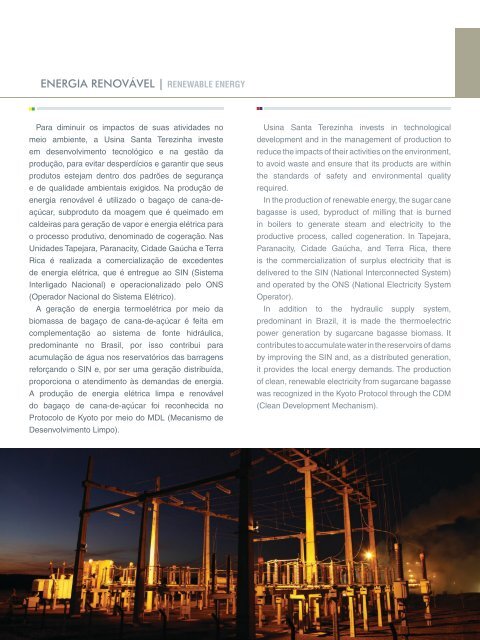SrgSzE
SrgSzE
SrgSzE
Create successful ePaper yourself
Turn your PDF publications into a flip-book with our unique Google optimized e-Paper software.
ENERGIA RENOVÁVEL | RENEWABLE ENERGY<br />
Para diminuir os impactos de suas atividades no<br />
meio ambiente, a Usina Santa Terezinha investe<br />
em desenvolvimento tecnológico e na gestão da<br />
produção, para evitar desperdícios e garantir que seus<br />
produtos estejam dentro dos padrões de segurança<br />
e de qualidade ambientais exigidos. Na produção de<br />
energia renovável é utilizado o bagaço de cana-deaçúcar,<br />
subproduto da moagem que é queimado em<br />
caldeiras para geração de vapor e energia elétrica para<br />
o processo produtivo, denominado de cogeração. Nas<br />
Unidades Tapejara, Paranacity, Cidade Gaúcha e Terra<br />
Rica é realizada a comercialização de excedentes<br />
de energia elétrica, que é entregue ao SIN (Sistema<br />
Interligado Nacional) e operacionalizado pelo ONS<br />
(Operador Nacional do Sistema Elétrico).<br />
A geração de energia termoelétrica por meio da<br />
biomassa de bagaço de cana-de-açúcar é feita em<br />
complementação ao sistema de fonte hidráulica,<br />
predominante no Brasil, por isso contribui para<br />
acumulação de água nos reservatórios das barragens<br />
reforçando o SIN e, por ser uma geração distribuída,<br />
proporciona o atendimento às demandas de energia.<br />
A produção de energia elétrica limpa e renovável<br />
do bagaço de cana-de-açúcar foi reconhecida no<br />
Protocolo de Kyoto por meio do MDL (Mecanismo de<br />
Desenvolvimento Limpo).<br />
Usina Santa Terezinha invests in technological<br />
development and in the management of production to<br />
reduce the impacts of their activities on the environment,<br />
to avoid waste and ensure that its products are within<br />
the standards of safety and environmental quality<br />
required.<br />
In the production of renewable energy, the sugar cane<br />
bagasse is used, byproduct of milling that is burned<br />
in boilers to generate steam and electricity to the<br />
productive process, called cogeneration. In Tapejara,<br />
Paranacity, Cidade Gaúcha, and Terra Rica, there<br />
is the commercialization of surplus electricity that is<br />
delivered to the SIN (National Interconnected System)<br />
and operated by the ONS (National Electricity System<br />
Operator).<br />
In addition to the hydraulic supply system,<br />
predominant in Brazil, it is made the thermoelectric<br />
power generation by sugarcane bagasse biomass. It<br />
contributes to accumulate water in the reservoirs of dams<br />
by improving the SIN and, as a distributed generation,<br />
it provides the local energy demands. The production<br />
of clean, renewable electricity from sugarcane bagasse<br />
was recognized in the Kyoto Protocol through the CDM<br />
(Clean Development Mechanism).<br />
RELATÓRIO DE SUSTENTABILIDADE 2013<br />
SUSTAINABILITY REPORT 2013<br />
77


